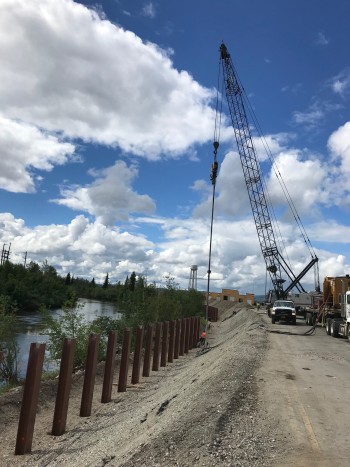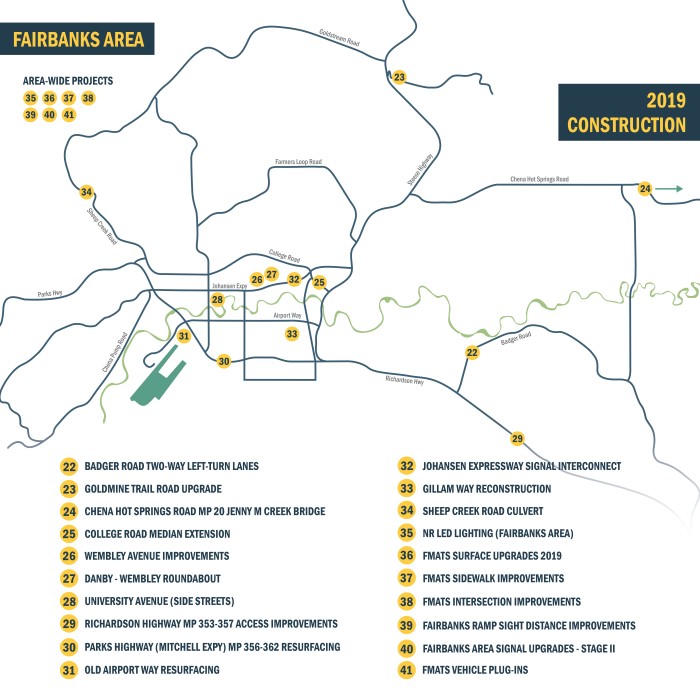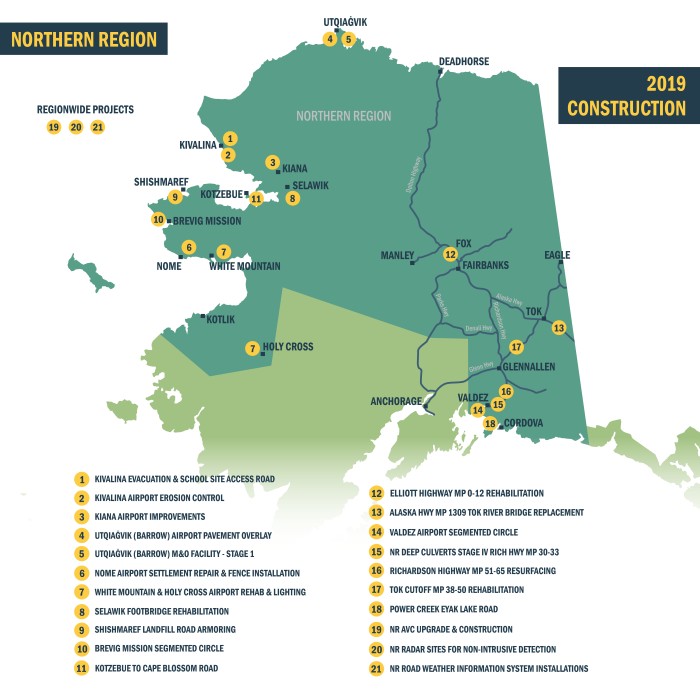2019 Construction Season Info
Alaska DOT&PF’s Northern Region is planning another busy construction season in 2019! This web page serves as a central location for information about this construction season, links to project websites, and general information about how our construction program operates.
Big numbers for 2019 construction in Northern Region
- $208 million: estimated total cost of construction contractor payments in 2019
- 90%: portion of this cost funded by the federal government
- 41: number of projects across Northern Region
- 14: number of communities in the Northern Region served by this year’s construction program

Reconstruction of University Avenue at Geist and Johansen in 2018. Photo credit to Brandy Milles, DOT&PF
Priorities in construction
We plan, design, and construct projects in order to accomplish three primary goals:
- Improve safety and mobility
- Preserve our existing infrastructure
- Reduce our operating costs
How an idea becomes a construction project
The projects you see constructed in 2019, and every other year, start with an evaluation of our state’s infrastructure needs. Out of these needs, projects are planned with the help of stakeholders and the public, funding from our federal partners is secured to begin the project, and the design process begins.
The design process includes completing the environmental document, getting feedback from stakeholders and the public about the project, acquiring any necessary right-of-way, making necessary agreements with utility companies, creating the detailed construction plan set, and estimating the cost of construction. This process can be completed entirely in-house, partially in-house with the assistance of a consultant, or primarily by a consultant with oversight from in-house staff.
When all that preparation work is complete and a project is ready to be delivered to construction, it is submitted to our federal partners for funding approval. If approved, the project is typically advertised to construction contractors who submit bids stating the price at which they can build the project. The contractor who meets the requirements of the bid advertisement and submits the lowest bid is generally awarded the project. In some cases, we use alternative procurement methods in which a construction price is negotiated with a contractor.
The awarded contractor will construct the project as specified in the plan set with contract oversight and quality control managed by DOT&PF staff.
Teaming in construction
Our projects are developed using a team approach. Here at DOT&PF’s Northern Region, we are organized into groups made up of employees with a variety of backgrounds, expertise, and job functions. We bring together design engineers, right-of-way agents, environmental analysts, construction engineers, and other key players to inform the project at the beginning of the design process. We also solicit feedback from maintenance personnel, funding partners, community members, businesses, and other stakeholders throughout project development.
This teamed approach helps head off potential problems early in the process, fosters creativity and innovation, ensures a variety of opinions and agendas are considered, and creates a sense of ownership across the department and the community.
Closures, detours, signs, and cones—how we manage traffic during construction
When making decisions about how to manage traffic through construction zones, we look at each project individually, consider how each project interacts with other construction projects in the area, and consider how detoured traffic impacts our transportation system as a whole. We try to balance several different factors:
- Safety of the public and the workers
- Impacts to businesses and the public
- Available funding
- Time to complete the project under a variety of conditions

The vast majority of funding for our road construction projects comes from the Federal Highway Administration (FHWA). For those federally-funded projects, FHWA requires us to look at closing a road as a first option to manage traffic. Generally this is not an option on our rural projects because of a lack of alternative routes. However, if there are reasonable detours around the construction zone, the existing transportation network can handle an increase in traffic, and a closure doesn’t block access to homes, business, or essential resources, this option can have significant benefits including:
- Decreasing the amount of time needed to complete the project
- Decreasing the cost of the project
- Increasing safety for workers and the traveling public
- Minimizing impacts on businesses
Here are two examples of our thought process while determining the traffic control plans for specific 2019 projects.
Mitchell Expressway
Is a full closure feasible? Yes, because there are no residential properties exclusively accessed by the Mitchell Expressway, all business access can be maintained through a full closure, and the existing transportation network can handle the increased traffic. The additional time needed to travel detour routes is similar to the expected delay if traffic were to be reduced to one lane in each direction through the construction zone.
How much money would be saved through a full closure? An informal cost analysis conducted by DOT&PF staff determined a full closure would save approximately $1 million.
How much time would be saved through a full closure? Our staff determined that the project cannot be completed in one construction season if two-way traffic is maintained throughout the work zone. With a full closure, the project can be completed in one season. The time needed to set up and remove traffic control devices if maintaining two-way traffic has a big impact on the project timeline. The contractor would need to set up temporary traffic control including temporary striping, temporary traffic signals, new signs, and additional traffic control devices like cones and barriers. These would have to be removed and reset when traffic moved to the other side and then removed again when the project or season is over. In addition, several ramps at the interchange between the Richardson Highway and Mitchell Expressway will need to be closed either way because the single-lane ramps are not wide enough to keep traffic flowing during construction.
Is a full closure the best choice? Yes. It will minimize the impact on the public and local businesses by reducing the length of time need to construct the project and it will save a significant amount of money.
Badger Road
Is a full closure feasible? No, because a full closure would block access to a large number of residences.
What can we do to minimize impacts without a full closure? We will wait to start mainline work until 8 a.m. to allow the morning rush of traffic to subside before pilot car operations begin. We will also split the work into three sections that will be constructed one at a time. This will minimize the distance local traffic has to travel through the work zone at any given time.
What’s coming in Fairbanks?

Construction season in Fairbanks is notoriously busy, and this year is no exception. Many of the projects listed above will have minimal impacts on traffic. Depending on where you live and work, however, some of these projects will significantly impact your commute.
For more information about specific projects, please visit our project websites. You will find contact information on each project website on the sidebar to the right. During construction season, you can find the most recent project updates and traffic impacts at AlaskaNavigator.org. Not all projects have websites, but all projects in construction will be listed on Alaska Navigator.
- Mitchell Expressway (Parks Highway MP 356-362) Resurfacing
- Richardson Highway MP 353-357 Access Improvements
- Badger Road Two-Way Left-Turn Lanes
- Gillam Way Reconstruction
- Danby – Wembley Roundabout
- Gold Mine Trail Road Upgrade
- Motor Vehicle Plug-Ins Project
- University Avenue Side Streets
What’s coming for the Northern Region?

Of the 28 rural projects we hope to construct in 2019:
- 15 are aviation projects or off the contiguous road system
- 8 are on the national highway system
- 5 are facility or equipment-related projects with minimal impacts to road traffic
You can find the most recent project updates, including traffic impacts, for projects affecting road travel, on AlaskaNavigator.org. For more information about select projects, visit the project websites.
More Information
Caitlin Frye,
Northern Region
Information Officer
![]() (907) 451-5307
(907) 451-5307
![]() caitlin.frye@alaska.gov
caitlin.frye@alaska.gov
2301 Peger Road
Fairbanks, AK 99709
PLEASE NOTE: Adobe Acrobat PDF files require a free viewer available directly from Adobe.
